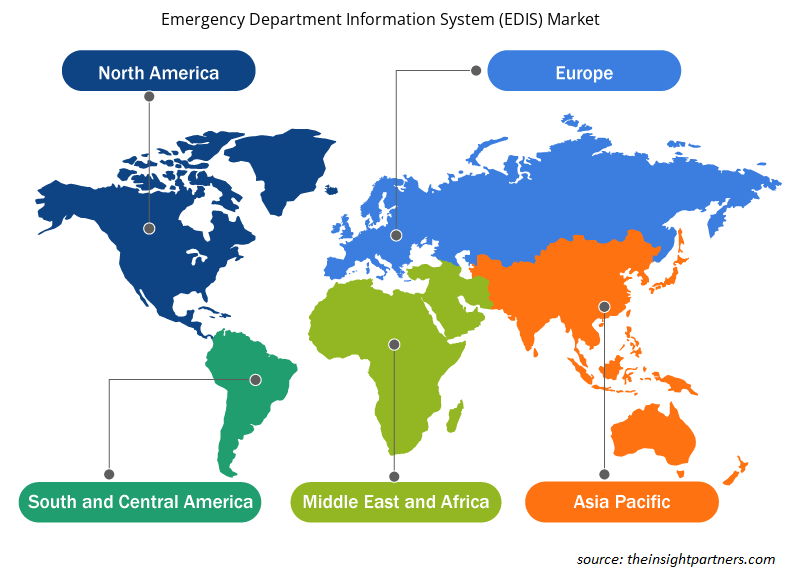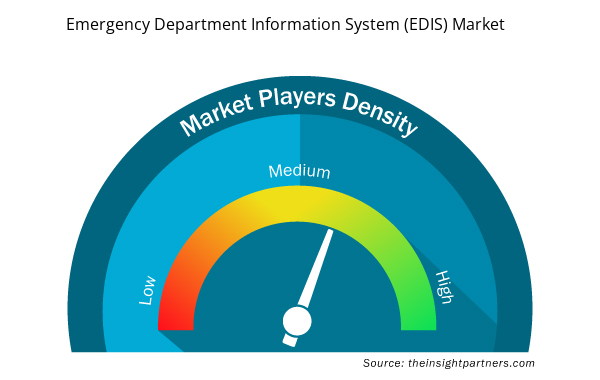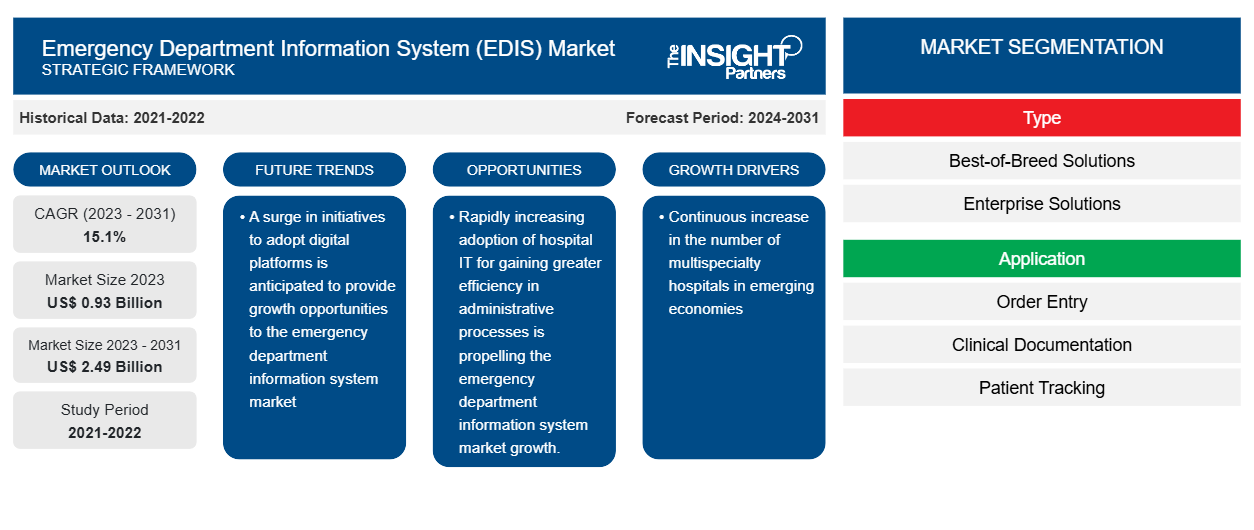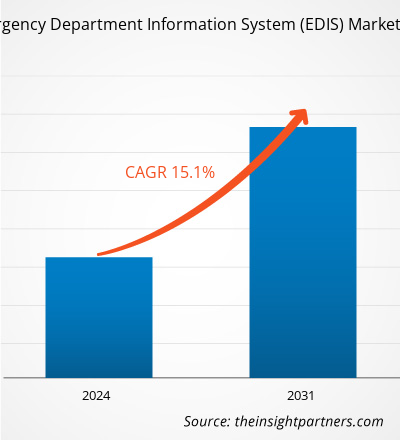Der Markt für Notaufnahmeinformationssysteme ( EDIS ) soll von 0,93 Milliarden US-Dollar im Jahr 2023 auf 2,49 Milliarden US-Dollar im Jahr 2031 anwachsen. Für den Zeitraum 2023–2031 wird ein durchschnittliches jährliches Wachstum von 15,10 % erwartet. Die Einführung cloudbasierter EDIS- Dienste wird wahrscheinlich ein wichtiger Trend auf dem Markt bleiben.
Marktanalyse für Notaufnahme-Informationssysteme ( EDIS )
Die wichtigsten Faktoren, die das Marktwachstum vorantreiben, sind eine Zunahme des Patientenaufkommens in Notaufnahmen und eine hohe Akzeptanz von Notaufnahme-Informationssystemen. Darüber hinaus dürfte der Fortschritt bei der Digitalisierung von Gesundheitsdienstleistungen in den kommenden Jahren Chancen für den Markt für Notaufnahme-Informationssysteme ( EDIS ) bieten.
Marktübersicht für Notaufnahme-Informationssysteme ( EDIS )
Der Rettungsdienst (EMS) umfasst die Akutversorgung von Patienten. Die EMS-Abteilungen behandeln Patienten mit medizinischen Komplikationen sowie geburtshilfliche und chirurgische Notfälle. Diese Abteilungen behandeln auch Verletzungen, Infektionen, Herzinfarkte , Schlaganfälle, Asthma und akute Schwangerschaftskomplikationen. Sie konzentrieren sich also in erster Linie auf die Versorgung von Patienten mit Verletzungen und notfallmäßigen Erkrankungen wie Schlaganfall und Herzstillstand. Dienstleistungen, die bei Naturkatastrophen erforderlich sind, fallen ebenfalls in die Kategorie EMS. Die Nachfrage nach Notfallversorgungsdiensten im Gesundheitswesen steigt aufgrund der zunehmenden Zahl von Herzstillständen und Unfällen. Nach Angaben des European Resuscitation Council liegt die gemeldete Zahl von Herzstillständen in Europa bei ~67-170 pro 100.000 Personen. Schätzungen von stroke.org.uk zufolge wird die Schlaganfalllast in Europa in den kommenden Jahren voraussichtlich deutlich zunehmen. Die in diesem Bericht enthaltenen Prognosen gehen davon aus, dass sich die Gesamtzahl der Schlaganfallfälle in der Europäischen Union im Zeitraum 2015–2035 um 34 % erhöhen wird. Die Fallzahl dürfte von 613.148 im Jahr 2015 auf 819.771 im Jahr 2035 ansteigen. Daher wird erwartet, dass die Zahl der Patienten in den Notaufnahmen in den kommenden Jahren steigen wird.
Passen Sie diesen Bericht Ihren Anforderungen an
Sie erhalten kostenlos individuelle Anpassungen an jedem Bericht, einschließlich Teilen dieses Berichts oder einer Analyse auf Länderebene, eines Excel-Datenpakets sowie tolle Angebote und Rabatte für Start-ups und Universitäten.
- Holen Sie sich die wichtigsten Markttrends aus diesem Bericht.Dieses KOSTENLOSE Beispiel umfasst eine Datenanalyse von Markttrends bis hin zu Schätzungen und Prognosen.
Markttreiber und Chancen für Notaufnahme-Informationssysteme ( EDIS )
Hohe Akzeptanz von Informationssystemen für Notaufnahmen
Notaufnahme-Informationssysteme ( EDIS ) verbessern die Nutzung von medizinischem Personal und Ressourcen, was bei der Verwaltung des Patientenflusses hilft. Die Systeme tragen auch zur Verbesserung der Entscheidungsfindung von Krankenhäusern bei, indem sie umfassende Echtzeitdaten für die Krankenhausverwaltung bereitstellen. Die EDIS -Lösungen senken die Kosten von Gesundheitseinrichtungen, indem sie die Arbeitskosten senken. Darüber hinaus ist die Nachfrage nach Notaufnahme-Informationssystemen in Nordamerika aufgrund der breiten Akzeptanz der Technologie in Ländern wie den USA und Kanada hoch. Außerdem dominiert Nordamerika den globalen Markt für Notaufnahme-Informationssysteme, gefolgt von Europa. Europa ist bekannt für die deutlich steigende Einführung der digitalen Transformation der Telematik im Gesundheitswesen in Gesundheitseinrichtungen, zusammen mit den wachsenden Ausgaben für die Gesundheitsinfrastruktur und der Verfügbarkeit technologisch fortschrittlicher Geräte. Darüber hinaus treibt die schnell zunehmende Einführung von Krankenhaus-IT zur Steigerung der Effizienz von Verwaltungsabläufen das Wachstum des Marktes für Notaufnahme-Informationssysteme voran.
Fortschritte bei der Digitalisierung von Gesundheitsdienstleistungen
In den letzten Jahren hat die Digitalisierung des Gesundheitswesens mit der Einführung der eHealth -Agenda in vielen Ländern zugenommen . eHealth kann die Qualität der Dienste verbessern und den Zugang der Benutzer zu Gesundheitsinformationen verbessern. Auch den Gesundheitsdienstleistern kann es helfen, Zeit zu sparen und den Arbeitsaufwand sowie die damit verbundenen Kosten langfristig zu reduzieren. Telemedizin , elektronische Gesundheitsakten ( EHR ), Online-Rezepte und Gesundheitsinformationssysteme sind einige der digitalen Lösungen, die bei der Umsetzung von eHealth genutzt werden können . Die Popularität digitaler Technologien wie geschützter Gesundheitsinformationen (PHI) hat in den letzten Jahren erheblich zugenommen. Laut kanadischen Ärzten ist der Prozentsatz ihrer Patienten, die digitale Technologien zur Verwaltung ihrer medizinischen Informationen nutzen, von 20,8 % im Jahr 2017 auf 44,7 % im Jahr 2019 gestiegen.
Marktbericht zu Notaufnahme-Informationssystemen ( EDIS ) – Segmentierungsanalyse
Wichtige Segmente, die zur Ableitung der Marktanalyse für Notaufnahmeinformationssysteme ( EDIS ) beigetragen haben, sind Typ, Anwendung und Endbenutzer.
- Basierend auf dem Typ ist der Markt für Notaufnahmeinformationssysteme ( EDIS ) in Best-of-Breed-Lösungen und Unternehmenslösungen unterteilt. Das Segment der Best-of-Breed-Lösungskits hatte im Jahr 2023 den größten Marktanteil.
- Basierend auf der Anwendung ist der Markt für Notaufnahmeinformationssysteme ( EDIS ) nach Auftragseingabe, klinischer Dokumentation, Patientenverfolgung, elektronischer Verschreibung und anderen segmentiert. Das Segment Auftragseingabebehandlung hatte im Jahr 2023 den größten Marktanteil.
- Basierend auf den Endnutzern ist der Markt für Notaufnahmeinformationssysteme ( EDIS ) in kleine Krankenhäuser, mittelgroße Krankenhäuser und große Krankenhäuser segmentiert. Das Segment der mittelgroßen Krankenhäuser hatte im Jahr 2023 den größten Marktanteil.
Marktanteilsanalyse für Notaufnahme-Informationssysteme ( EDIS ) nach geografischer Lage
Der geografische Umfang des Marktberichts zum Notaufnahmeinformationssystem (EDIS) ist hauptsächlich in fünf Regionen unterteilt: Nordamerika, Asien-Pazifik, Europa, Naher Osten und Afrika sowie Süd- und Mittelamerika.
Die COVID-19-Pandemie hat die Notaufnahmen in der Region dazu veranlasst, IT-Dienste im Gesundheitswesen in Anspruch zu nehmen. Aufgrund des Ausbruchs sind Interoperabilität, verknüpfte Patientenakten, genaue Patientendaten und Cybersicherheit für mHealth und elektronische Krankenakten im Gesundheitssektor wichtiger denn je geworden. Darüber hinaus wird die Bevölkerung altern und anfälliger für Langzeiterkrankungen, was zu einem Anstieg der Krankenhauseinweisungen und einem steigenden Bedarf an Informationssystemen für Notaufnahmen führen wird. Basierend auf dem 2020 Profile of Older Americans, das von der Administration for Community Living veröffentlicht wurde, wird die Zahl der Amerikaner über 65 bis 2040 voraussichtlich auf 80,58 Millionen und bis 2060 auf 94,7 Millionen steigen.
Regionale Einblicke in den Markt für Notaufnahmeinformationssysteme (EDIS)
Die regionalen Trends und Faktoren, die den Markt für Notaufnahmeinformationssysteme (EDIS) während des gesamten Prognosezeitraums beeinflussen, wurden von den Analysten von Insight Partners ausführlich erläutert. In diesem Abschnitt werden auch Marktsegmente und Geografien für Notaufnahmeinformationssysteme (EDIS) in Nordamerika, Europa, im asiatisch-pazifischen Raum, im Nahen Osten und Afrika sowie in Süd- und Mittelamerika erörtert.

- Erhalten Sie regionale Daten zum Markt für Notaufnahme-Informationssysteme (EDIS)
Umfang des Marktberichts zum Notaufnahmeinformationssystem (EDIS)
| Berichtsattribut | Details |
|---|---|
| Marktgröße im Jahr 2023 | 0,93 Milliarden US-Dollar |
| Marktgröße bis 2031 | 2,49 Milliarden US-Dollar |
| Globale CAGR (2023 - 2031) | 15,1 % |
| Historische Daten | 2021-2022 |
| Prognosezeitraum | 2024–2031 |
| Abgedeckte Segmente | Nach Typ
|
| Abgedeckte Regionen und Länder | Nordamerika
|
| Marktführer und wichtige Unternehmensprofile |
|
Dichte der Marktteilnehmer für Notaufnahmeinformationssysteme (EDIS): Auswirkungen auf die Geschäftsdynamik verstehen
Der Markt für Informationssysteme für Notaufnahmen (EDIS) wächst rasant, angetrieben durch die steigende Nachfrage der Endnutzer aufgrund von Faktoren wie sich entwickelnden Verbraucherpräferenzen, technologischen Fortschritten und einem größeren Bewusstsein für die Vorteile des Produkts. Mit der steigenden Nachfrage erweitern Unternehmen ihr Angebot, entwickeln Innovationen, um die Bedürfnisse der Verbraucher zu erfüllen, und nutzen neue Trends, was das Marktwachstum weiter ankurbelt.
Die Marktteilnehmerdichte bezieht sich auf die Verteilung der Firmen oder Unternehmen, die in einem bestimmten Markt oder einer bestimmten Branche tätig sind. Sie gibt an, wie viele Wettbewerber (Marktteilnehmer) in einem bestimmten Marktraum im Verhältnis zu seiner Größe oder seinem gesamten Marktwert präsent sind.
Die wichtigsten Unternehmen auf dem Markt für Notaufnahmeinformationssysteme (EDIS) sind:
- Allscripts Healthcare LLC
- Cerner Corporation
- eHealth-Tec
- Epic Systems Corporation
- Medizinische Informationstechnologie, Inc.
- Q-nomy, Inc
Haftungsausschluss : Die oben aufgeführten Unternehmen sind nicht in einer bestimmten Reihenfolge aufgeführt.

- Erhalten Sie einen Überblick über die wichtigsten Akteure auf dem Markt für Notaufnahmeinformationssysteme (EDIS)
Marktnachrichten und aktuelle Entwicklungen zum Notaufnahmeinformationssystem (EDIS)
Der Markt für Notaufnahmeinformationssysteme (EDIS) wird durch die Erfassung qualitativer und quantitativer Daten nach Primär- und Sekundärforschung bewertet, die wichtige Unternehmensveröffentlichungen, Verbandsdaten und Datenbanken umfasst. Nachfolgend sind einige der Entwicklungen auf dem Markt für Notaufnahmeinformationssysteme (EDIS) aufgeführt:
- Augmedix gab die allgemeine Verfügbarkeit von Augmedix Go für Notaufnahmen bekannt und läutet damit die Einführung des branchenweit ersten vollautomatischen, generativen KI-gestützten (GenAI) medizinischen Dokumentationsprodukts für Notaufnahmen im ganzen Land ein. (Quelle: Augmedix, Unternehmenswebsite, April 2024)
Marktbericht zu Informationssystemen für Notaufnahmen (EDIS) – Umfang und Ergebnisse
Der Bericht „Marktgröße und Prognose für Informationssysteme für Notaufnahmen (EDIS) (2021–2031)“ bietet eine detaillierte Analyse des Marktes, die die folgenden Bereiche abdeckt:
- Marktgröße und Prognose für Notaufnahmeinformationssysteme (EDIS) auf globaler, regionaler und Länderebene für alle wichtigen Marktsegmente, die im Rahmen des Berichts abgedeckt sind
- Markttrends für Notaufnahmeinformationssysteme (EDIS) sowie Marktdynamiken wie Treiber, Einschränkungen und wichtige Chancen
- Detaillierte PEST/Porters Five Forces- und SWOT-Analyse
- Marktanalyse für Notaufnahmeinformationssysteme (EDIS), die wichtige Markttrends, globale und regionale Rahmenbedingungen, wichtige Akteure, Vorschriften und aktuelle Marktentwicklungen abdeckt.
- Branchenlandschaft und Wettbewerbsanalyse, die die Marktkonzentration, Heatmap-Analyse, prominente Akteure und aktuelle Entwicklungen für den Markt für Notaufnahmeinformationssysteme (EDIS) umfasst
- Detaillierte Firmenprofile
- Historische Analyse (2 Jahre), Basisjahr, Prognose (7 Jahre) mit CAGR
- PEST- und SWOT-Analyse
- Marktgröße Wert/Volumen – Global, Regional, Land
- Branche und Wettbewerbsumfeld
- Excel-Datensatz



Report Coverage
Revenue forecast, Company Analysis, Industry landscape, Growth factors, and Trends

Segment Covered
This text is related
to segments covered.

Regional Scope
North America, Europe, Asia Pacific, Middle East & Africa, South & Central America

Country Scope
This text is related
to country scope.
Häufig gestellte Fragen
North America dominated the emergency department information system (EDIS) market in 2023
Key factors that are driving the growth of the market are an increase in patient flow at emergency departments and a high adoption rate of emergency department information systems. However, the requirement of huge investment and a dearth of skilled healthcare IT professionals is expected to restrict the market growth during the forecast period.
The emergence of cloud-based edis services will likely remain a key trend in the market.
Allscripts Healthcare LLC, Cerner Corporation, eHealth-Tec, Epic Systems Corporation, Medical Information Technology, Inc, Q-nomy, Inc, Picis, Vital, EMIS Health, Sublimd, Medsphere System Corporation, MEDHOST.
The market is expected to register a CAGR of 15.1% during 2023–2031.
Trends and growth analysis reports related to Technology, Media and Telecommunications : READ MORE..
The Insight Partners performs research in 4 major stages: Data Collection & Secondary Research, Primary Research, Data Analysis and Data Triangulation & Final Review.
- Data Collection and Secondary Research:
As a market research and consulting firm operating from a decade, we have published and advised several client across the globe. First step for any study will start with an assessment of currently available data and insights from existing reports. Further, historical and current market information is collected from Investor Presentations, Annual Reports, SEC Filings, etc., and other information related to company’s performance and market positioning are gathered from Paid Databases (Factiva, Hoovers, and Reuters) and various other publications available in public domain.
Several associations trade associates, technical forums, institutes, societies and organization are accessed to gain technical as well as market related insights through their publications such as research papers, blogs and press releases related to the studies are referred to get cues about the market. Further, white papers, journals, magazines, and other news articles published in last 3 years are scrutinized and analyzed to understand the current market trends.
- Primary Research:
The primarily interview analysis comprise of data obtained from industry participants interview and answers to survey questions gathered by in-house primary team.
For primary research, interviews are conducted with industry experts/CEOs/Marketing Managers/VPs/Subject Matter Experts from both demand and supply side to get a 360-degree view of the market. The primary team conducts several interviews based on the complexity of the markets to understand the various market trends and dynamics which makes research more credible and precise.
A typical research interview fulfils the following functions:
- Provides first-hand information on the market size, market trends, growth trends, competitive landscape, and outlook
- Validates and strengthens in-house secondary research findings
- Develops the analysis team’s expertise and market understanding
Primary research involves email interactions and telephone interviews for each market, category, segment, and sub-segment across geographies. The participants who typically take part in such a process include, but are not limited to:
- Industry participants: VPs, business development managers, market intelligence managers and national sales managers
- Outside experts: Valuation experts, research analysts and key opinion leaders specializing in the electronics and semiconductor industry.
Below is the breakup of our primary respondents by company, designation, and region:

Once we receive the confirmation from primary research sources or primary respondents, we finalize the base year market estimation and forecast the data as per the macroeconomic and microeconomic factors assessed during data collection.
- Data Analysis:
Once data is validated through both secondary as well as primary respondents, we finalize the market estimations by hypothesis formulation and factor analysis at regional and country level.
- Macro-Economic Factor Analysis:
We analyse macroeconomic indicators such the gross domestic product (GDP), increase in the demand for goods and services across industries, technological advancement, regional economic growth, governmental policies, the influence of COVID-19, PEST analysis, and other aspects. This analysis aids in setting benchmarks for various nations/regions and approximating market splits. Additionally, the general trend of the aforementioned components aid in determining the market's development possibilities.
- Country Level Data:
Various factors that are especially aligned to the country are taken into account to determine the market size for a certain area and country, including the presence of vendors, such as headquarters and offices, the country's GDP, demand patterns, and industry growth. To comprehend the market dynamics for the nation, a number of growth variables, inhibitors, application areas, and current market trends are researched. The aforementioned elements aid in determining the country's overall market's growth potential.
- Company Profile:
The “Table of Contents” is formulated by listing and analyzing more than 25 - 30 companies operating in the market ecosystem across geographies. However, we profile only 10 companies as a standard practice in our syndicate reports. These 10 companies comprise leading, emerging, and regional players. Nonetheless, our analysis is not restricted to the 10 listed companies, we also analyze other companies present in the market to develop a holistic view and understand the prevailing trends. The “Company Profiles” section in the report covers key facts, business description, products & services, financial information, SWOT analysis, and key developments. The financial information presented is extracted from the annual reports and official documents of the publicly listed companies. Upon collecting the information for the sections of respective companies, we verify them via various primary sources and then compile the data in respective company profiles. The company level information helps us in deriving the base number as well as in forecasting the market size.
- Developing Base Number:
Aggregation of sales statistics (2020-2022) and macro-economic factor, and other secondary and primary research insights are utilized to arrive at base number and related market shares for 2022. The data gaps are identified in this step and relevant market data is analyzed, collected from paid primary interviews or databases. On finalizing the base year market size, forecasts are developed on the basis of macro-economic, industry and market growth factors and company level analysis.
- Data Triangulation and Final Review:
The market findings and base year market size calculations are validated from supply as well as demand side. Demand side validations are based on macro-economic factor analysis and benchmarks for respective regions and countries. In case of supply side validations, revenues of major companies are estimated (in case not available) based on industry benchmark, approximate number of employees, product portfolio, and primary interviews revenues are gathered. Further revenue from target product/service segment is assessed to avoid overshooting of market statistics. In case of heavy deviations between supply and demand side values, all thes steps are repeated to achieve synchronization.
We follow an iterative model, wherein we share our research findings with Subject Matter Experts (SME’s) and Key Opinion Leaders (KOLs) until consensus view of the market is not formulated – this model negates any drastic deviation in the opinions of experts. Only validated and universally acceptable research findings are quoted in our reports.
We have important check points that we use to validate our research findings – which we call – data triangulation, where we validate the information, we generate from secondary sources with primary interviews and then we re-validate with our internal data bases and Subject matter experts. This comprehensive model enables us to deliver high quality, reliable data in shortest possible time.


 Holen Sie sich ein kostenloses Muster für diesen Bericht
Holen Sie sich ein kostenloses Muster für diesen Bericht